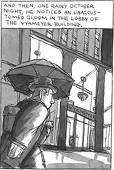 So many books, so little time.
So many books, so little time.
It was in the year 1859 that British literary critic David Masson noted that something astounding was happening to English literature. Two novels were being published in London each week, Masson observed, making it impossible for readers to keep up with the entirety of modern fiction. Henceforth, each person would have to hack his own path through the tangled jungle of literature, he noted. No two people would have the same experience.
Today, the pace of literary production has vastly increased and we seem to have far less time and inclination for the sort of books that the Victorians called “triple deckers” — Vanity Fair, Anna Karenina, David Copperfield and the like. Back then, reading was the primary form of entertainment. Today, we have movies, television, the internet, i-pods, and many other distractions.
As a reader I admit I cut corners occasionally, but always with care: reading cannot be done in a hurry. “I took a speed-reading course and read War and Peace in twenty minutes,” Woody Allen once quipped. “It involves Russia.”
I always groan when faced with a new book whose covers are too far apart. In this day and age, such excessive avoirdupuis seems an authorly conceit. However, I groan even louder if the book proves “too good to put down.”
Given the attention span of the modern reader, the modern graphic novel seems a logical innovation. Since a picture is worth 1,000 words, the format delivers narrative information in a much more concentrated form.
The term became popular after it appeared on the cover of Will Eisner’s book A Contract with God in 1978, and gained more respectability after Art Spiegelman’s 1986 book Maus won the Pulitzer Prize. A debate still rages, however, whether the term is just a fancy way of saying “comic book” but with a more expensive price tag.
By coincidence, three books in the “graphic-novel” style reached my desk in November. Upon further inspection, only one is a true graphic novel: the others are a glorified travelogue and a visual memoir. No matter: I’m pleased to review all three in this space.
Although I disagree ideologically with it, I must commend Sarah Glidden’s book, How to Understand Israel in 60 Days or Less, as being sensitively written, elegantly drawn, and charming despite its author’s primary impetus to determine the extent of Israel’s guilt in the face of international condemnation.
Glidden is, after all, just a “kid,” only 30 years old, and this is her first published work. She makes her first journey to Israel under the auspices of the Birthright program. She records her travels through Tel Aviv, Jerusalem, the Golan Heights, Galilee, Masada and other historic locales in a progression of pleasing, photography-influenced watercolours (presented in full colour). In so many ways she captures the flavour and visual look of Israel.
Glidden, alas, carries a great many harsh criticisms of the Jewish nation in her baggage. She regards much of what she hears on the Birthright trip as “propaganda,” but becomes increasingly disconcerted to find alternate opinions, and justifications for Israel, that make sense. Despite herself, she finds that she increasingly identifies with sympathy to Israel’s existential conundrum. The trip forces her to challenge her beliefs and her own identity as a Jew. Her book is published by Vertigo and costs $28.99 in Canada.
Two Cents Plain: My Brooklyn Boyhood, by Martin Lemelman, is a black-and-white graphic memoir by a child of Holocaust survivors who operate a candy store in Brooklyn. Lemelman is sensitive, poignant, nostalgic, funny, bitterly ironic and caustic as he recounts his childhood in a series of cleverly-drawn vignettes.
The comic-book format does not clash with the serious and complex subject matter — a fact that has already been well established through such master works as Maus and Toronto artist Bernice Eisenstein’s 2007 graphic novel I Was a Child of Holocaust Survivors.
Lemelman conveys the sights, sounds, smells and impressions of his Brooklyn boyhood and his family history in a manner that seems just as vivid and immediate as anything by Marcel Proust. The publisher is Bloomsbury; the price is (US) $26.
For readers of the English-language weekly Forward newspaper, Ben Katchor’s cartoons are addictive. He presents an off-beat fantasy world that is based on the known world but that serves to demonstrate how bizarre the real world actually is. The author of two former graphic novels, Katchor has just produced The Cardboard Valise, his first new book in more than a decade.
The Cardboard Valise seems more fantastical than his previous work. It involves an exotically farflung place called Outer Canthus which remains just as New York-centric as all other places he has drawn. Full of images of urban decay, his work remains as quirky, funny and surreal as a Roz Chast drawing in The New Yorker. The book is coming from the Pantheon Press in February 2011. ♦
© 2010






